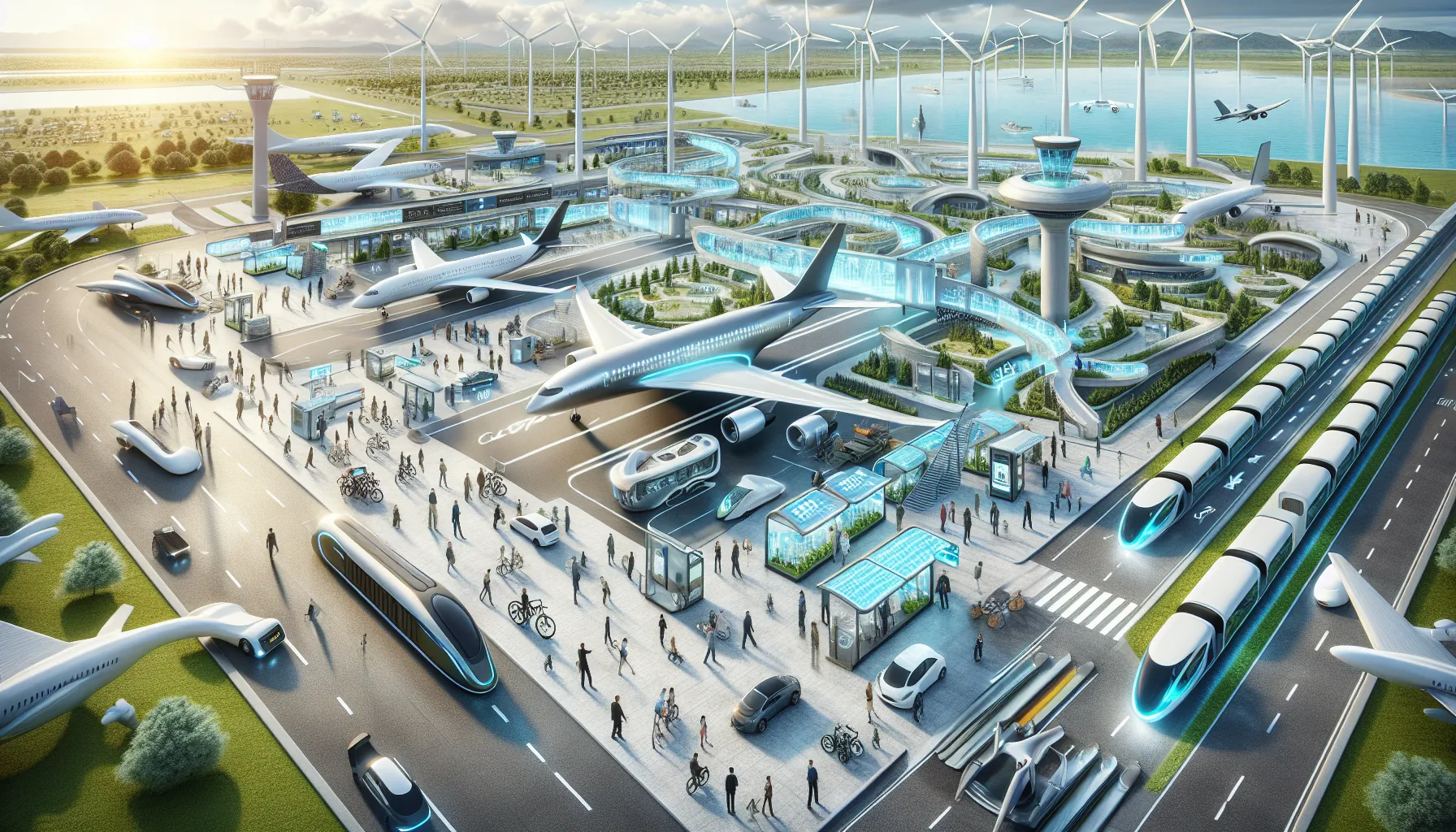Welcome to our IELTS Reading practice session focusing on the impact of electric aviation on global transportation networks. This comprehensive practice test will help you prepare for the IELTS Reading section by providing a realistic exam experience with passages of varying difficulty levels and a range of question types.
 Electric aircraft revolutionizing global transportation
Electric aircraft revolutionizing global transportation
Introduction
The aviation industry is undergoing a significant transformation with the advent of electric aircraft. This shift towards sustainable air travel is expected to have far-reaching effects on global transportation networks. In this IELTS Reading practice, we’ll explore various aspects of electric aviation and its potential impact on the future of transportation.
IELTS Reading Practice Test
Passage 1 (Easy Text)
The Rise of Electric Aviation
Electric aviation is rapidly gaining momentum as a promising solution to reduce the environmental impact of air travel. Unlike conventional aircraft that rely on fossil fuels, electric planes use batteries or hybrid-electric systems to power their engines. This technological advancement has the potential to revolutionize the aviation industry and transform global transportation networks.
One of the primary advantages of electric aircraft is their reduced carbon footprint. By eliminating the need for traditional jet fuel, these planes can significantly decrease greenhouse gas emissions associated with air travel. This aligns with global efforts to combat climate change and meet ambitious carbon reduction targets set by international agreements.
Moreover, electric planes offer the prospect of quieter flights, which could have positive implications for airports located near residential areas. The reduction in noise pollution may allow for extended operating hours and increased flight frequencies, potentially enhancing the efficiency of air transportation networks.
However, the widespread adoption of electric aviation faces several challenges. Battery technology remains a limiting factor, as current batteries lack the energy density required for long-haul flights. Additionally, the infrastructure needed to support electric aircraft, such as charging stations at airports, must be developed on a large scale.
Despite these obstacles, many airlines and aerospace companies are investing heavily in electric aviation research and development. As technology advances and becomes more cost-effective, we can expect to see an increasing number of electric aircraft entering service, particularly for short-haul and regional flights.
The impact of electric aviation on global transportation networks is likely to be substantial. It may lead to the emergence of new route structures, with an emphasis on shorter, more frequent flights between regional airports. This could potentially alleviate congestion at major hubs and improve connectivity for underserved communities.
In conclusion, while electric aviation is still in its early stages, its potential to reshape the future of air travel and global transportation networks is significant. As technology continues to evolve, we may witness a transformation in how we move around the world, with electric aircraft playing a central role in creating a more sustainable and efficient transportation ecosystem.
Questions 1-7: Identifying Information (True/False/Not Given)
Do the following statements agree with the information given in the passage? Write
TRUE if the statement agrees with the information
FALSE if the statement contradicts the information
NOT GIVEN if there is no information on this
- Electric aircraft use batteries or hybrid-electric systems instead of fossil fuels.
- Electric planes produce more greenhouse gas emissions than conventional aircraft.
- Reduced noise pollution from electric aircraft may allow for longer operating hours at airports.
- Current battery technology is sufficient for long-haul electric flights.
- Many airlines are investing in electric aviation research and development.
- Electric aviation may lead to more frequent flights between regional airports.
- All major airports are currently equipped with charging stations for electric aircraft.
Questions 8-13: Sentence Completion
Complete the sentences below. Choose NO MORE THAN TWO WORDS from the passage for each answer.
- Electric aviation is seen as a promising solution to reduce the __ __ of air travel.
- One advantage of electric aircraft is their reduced __ __.
- Electric planes offer the prospect of __ flights, which could benefit airports near residential areas.
- The widespread adoption of electric aviation faces challenges, including limitations in __ __.
- Electric aviation may lead to the emergence of new __ __, focusing on shorter flights.
- The transformation of air travel through electric aviation aims to create a more __ and efficient transportation ecosystem.
Passage 2 (Medium Text)
Reshaping Global Transportation Networks
The advent of electric aviation is poised to have a profound impact on global transportation networks, potentially reshaping the way we conceive and utilize air travel. As this technology matures, it is expected to influence not only the aviation industry but also intermodal transportation systems, urban planning, and economic development patterns worldwide.
One of the most significant changes that electric aviation may bring about is the revitalization of regional airports. Currently, many smaller airports struggle to maintain regular commercial services due to the high operational costs associated with conventional aircraft. Electric planes, with their lower operating expenses and reduced noise footprint, could make short-haul flights more economically viable. This could lead to a decentralization of air traffic, with an increased number of point-to-point connections between secondary cities and rural areas.
The integration of electric aircraft into the broader transportation ecosystem may also foster the development of new intermodal hubs. These facilities would seamlessly connect electric air travel with other sustainable transportation modes such as high-speed rail, electric buses, and shared mobility services. Such integration could significantly enhance the efficiency of long-distance travel, reducing overall journey times and improving accessibility to remote regions.
Moreover, the adoption of electric aviation could catalyze changes in urban and regional planning. As the range of electric aircraft improves, it may become feasible to develop aerotropolises – urban sub-centers built around airports – in locations that were previously considered impractical for air connectivity. This could lead to new patterns of economic development and potentially alleviate pressure on overcrowded metropolitan areas.
The environmental benefits of electric aviation extend beyond reduced carbon emissions. By decreasing the reliance on fossil fuels, this technology could help mitigate the volatility of fuel prices, which has long been a significant factor in the economics of air travel. Additionally, the quieter operation of electric aircraft may allow for more flexible flight paths and landing approaches, potentially increasing the capacity of existing airports without expanding their physical footprint.
However, the transition to electric aviation will require substantial investments in infrastructure. Airports will need to be equipped with high-capacity charging systems and energy storage facilities to support electric aircraft operations. The electrical grid in many regions may also require upgrades to handle the increased demand. These infrastructure challenges present both obstacles and opportunities for economic growth and job creation in the green energy sector.
The impact of electric aviation on global supply chains and cargo transportation should not be overlooked. As technology advances, electric cargo planes could offer more frequent and flexible shipping options, particularly for time-sensitive goods. This could lead to a reconfiguration of logistics networks, with a greater emphasis on just-in-time delivery and reduced inventory holding costs.
In conclusion, the rise of electric aviation has the potential to fundamentally alter global transportation networks. By enabling more distributed air travel, fostering intermodal connectivity, and promoting sustainable development, electric aircraft may usher in a new era of mobility. However, realizing this potential will require coordinated efforts from governments, industry stakeholders, and communities to address the technological, infrastructural, and regulatory challenges that lie ahead.
Questions 14-18: Multiple Choice
Choose the correct letter, A, B, C, or D.
-
According to the passage, electric aviation is likely to:
A) Increase the number of large international airports
B) Reduce the importance of air travel in global transportation
C) Lead to more connections between smaller cities and rural areas
D) Eliminate the need for regional airports -
The integration of electric aircraft with other transportation modes is expected to:
A) Replace high-speed rail systems
B) Increase overall journey times
C) Improve accessibility to remote regions
D) Reduce the need for intermodal hubs -
The development of aerotropolises around airports is mentioned as:
A) A current trend in urban planning
B) A potential result of improved electric aircraft range
C) An obstacle to economic development
D) A solution to overcrowding in city centers -
The quieter operation of electric aircraft may:
A) Necessitate the expansion of airport runways
B) Allow for more flexible flight paths
C) Reduce the capacity of existing airports
D) Increase noise pollution in residential areas -
The passage suggests that the transition to electric aviation will require:
A) Minimal changes to existing airport infrastructure
B) Significant investments in charging systems and energy storage
C) Reduction in the number of operational airports
D) Decreased emphasis on green energy jobs
Questions 19-22: Matching Headings
Match the following headings to the correct paragraphs in the passage. Write the correct number i-vii next to questions 19-22.
i. Environmental and Economic Advantages
ii. Challenges in Infrastructure Development
iii. Potential for Regional Airport Growth
iv. Impact on Urban Planning and Development
v. Revolutionizing Cargo Transportation
vi. Integration with Sustainable Transportation Modes
vii. The Future of Global Air Travel Networks
- Paragraph 2: __
- Paragraph 3: __
- Paragraph 4: __
- Paragraph 6: __
Passage 3 (Hard Text)
The Paradigm Shift: Electric Aviation and its Global Ramifications
The emergence of electric aviation represents a paradigm shift in the realm of global transportation, promising to revolutionize not only how we traverse the skies but also how we conceptualize mobility, urban development, and environmental sustainability. This technological leap forward is poised to catalyze a series of interconnected transformations that will reverberate throughout the global economy and society at large.
At the heart of this revolution lies the propulsion technology that powers electric aircraft. Unlike conventional jet engines, which rely on the combustion of fossil fuels, electric propulsion systems utilize high-capacity batteries or hybrid-electric configurations. This fundamental change in power source brings with it a host of advantages, including significantly reduced carbon emissions, lower operating costs, and diminished noise pollution. However, it also presents formidable challenges, particularly in terms of energy density and range limitations.
The potential ramifications of widespread electric aviation adoption are multifaceted and far-reaching. From an environmental perspective, the reduction in greenhouse gas emissions could contribute substantially to global efforts to mitigate climate change. The aviation industry, long criticized for its outsized carbon footprint, could potentially transition from being a major polluter to a beacon of sustainable transportation. This shift aligns with the growing global consensus on the need for decarbonization across all sectors of the economy.
Economically, the advent of electric aviation could trigger a restructuring of the airline industry. The lower operating costs associated with electric aircraft may enable the proliferation of new business models, potentially democratizing air travel and making it more accessible to a broader segment of the population. Furthermore, the maintenance and servicing requirements of electric aircraft differ significantly from those of conventional planes, necessitating a retraining of the workforce and the development of new specialized skills.
From an urban planning perspective, the quieter operation of electric aircraft could revolutionize airport design and location. Airports, traditionally relegated to the peripheries of urban areas due to noise concerns, could potentially be integrated more seamlessly into city centers. This could lead to the development of urban air mobility ecosystems, where electric vertical takeoff and landing (eVTOL) vehicles provide rapid intra-city and inter-city transportation, complementing existing ground-based transit systems.
The impact on global transportation networks extends beyond passenger travel. The cargo sector, a critical component of global supply chains, stands to be significantly affected by the adoption of electric aviation. The potential for more frequent, flexible, and cost-effective air freight services could reshape logistics strategies worldwide, potentially leading to more distributed manufacturing and altered patterns of international trade.
However, the transition to electric aviation is not without its challenges. The development of charging infrastructure at airports represents a significant hurdle, requiring substantial investment and coordination among various stakeholders. Moreover, the increased electricity demand could strain existing power grids, necessitating upgrades and the integration of renewable energy sources to truly realize the environmental benefits of electric aviation.
The regulatory landscape will also need to evolve to accommodate this new technology. Aviation authorities worldwide will need to develop new certification standards, safety protocols, and air traffic management systems tailored to the unique characteristics of electric aircraft. This regulatory adaptation process could significantly influence the pace and direction of electric aviation’s integration into global transportation networks.
The geopolitical implications of this shift should not be underestimated. Countries and regions that take the lead in electric aviation technology and infrastructure development could gain significant economic and strategic advantages. This could potentially alter the balance of power in the global aerospace industry, with ramifications for international trade, technological cooperation, and even military capabilities.
In conclusion, the impact of electric aviation on global transportation networks represents a complex and multifaceted transformation that extends far beyond the realm of air travel. As this technology matures and is increasingly integrated into the global transportation ecosystem, it has the potential to reshape urban landscapes, alter economic structures, and contribute to environmental sustainability efforts. However, realizing this potential will require concerted efforts to overcome technological, infrastructural, and regulatory challenges. The coming decades will likely witness a period of rapid innovation and adaptation as the world grapples with the profound implications of this revolutionary shift in aviation technology.
Questions 23-26: Matching Information
Match the following statements (A-F) with the correct paragraph (23-26) in the passage. Write the correct letter A-F next to questions 23-26.
A) The need for new regulatory frameworks to govern electric aviation
B) The potential for electric aviation to democratize air travel
C) The core technological difference between electric and conventional aircraft
D) The possible integration of airports into urban centers
E) The challenge of developing appropriate charging infrastructure
F) The environmental benefits of transitioning to electric aviation
- Paragraph 2: __
- Paragraph 3: __
- Paragraph 5: __
- Paragraph 7: __
Questions 27-30: Summary Completion
Complete the summary below. Choose NO MORE THAN TWO WORDS from the passage for each answer.
Electric aviation represents a (27) __ __ in global transportation, offering numerous advantages such as reduced emissions and lower operating costs. However, it also faces challenges, particularly in terms of (28) __ __ and range limitations. The adoption of electric aircraft could lead to a (29) __ __ of the airline industry and the development of new urban air mobility systems. To fully realize the potential of electric aviation, significant investments in (30) __ __ at airports will be necessary, along with adaptations in regulatory frameworks and workforce skills.
Questions 31-35: Matching Features
Match the following features (A-G) with their corresponding impacts or challenges (31-35) related to electric aviation. Write the correct letter A-G next to questions 31-35.
Features:
A) Lower operating costs
B) Reduced noise pollution
C) Increased electricity demand
D) Altered maintenance requirements
E) More flexible air freight services
F) Technological leadership
G) Lower carbon emissions
Impacts or Challenges:
31. Potential strain on existing power grids: __
32. Reshaping of global supply chains: __
33. Contribution to climate change mitigation efforts: __
34. Possible relocation of airports closer to city centers: __
35. Potential geopolitical advantages for certain countries: __
Questions 36-40: Identifying Writer’s Views (Yes/No/Not Given)
Do the following statements reflect the views of the writer in the passage? Write
YES if the statement reflects the writer’s views
NO if the statement contradicts the writer’s views
NOT GIVEN if it is impossible to say what the writer thinks about this
- Electric aviation will completely replace conventional air travel within the next decade.
- The transition to electric aviation will require significant changes in workforce training and skills.
- Urban air mobility systems using electric aircraft will definitely solve all urban transportation problems.
- The development of electric aviation technology could influence the balance of power in the global aerospace industry.
- The challenges facing electric aviation adoption are insurmountable and will prevent its widespread implementation.
Answer Key
Passage 1
- TRUE
- FALSE
- TRUE
- FALSE
- TRUE
- TRUE
- NOT GIVEN
- environmental impact
- carbon footprint
- quieter
- battery technology
- route structures
- sustainable
Passage 2
- C
- C
- B
- B
- B
- iii
- vi
- iv
- ii
Passage 3
- C
- F
- D
- E
- paradigm shift
- energy density
- restructuring
- charging infrastructure
- C
- E
- G
- B
- F
- NOT GIVEN
- YES
- NOT GIVEN
- YES
- NO
Conclusion
This IELTS Reading practice test on the impact of electric aviation on global transportation networks has provided you with a comprehensive examination of various aspects related to this emerging technology. By engaging with these passages and questions, you’ve not only practiced your reading skills but also gained valuable insights into a topic that is shaping the future of global transportation.
Remember, success in the IELTS Reading section comes from regular practice and familiarity with different question types. Keep honing your skills by exploring more practice tests on various topics. If you’re interested in related subjects, you might want to check out our articles on the role of electric vehicles in reducing air pollution and [how climate change is impacting global transportation networks](https://www


